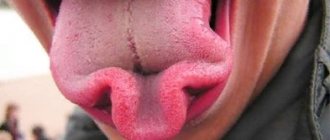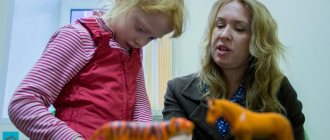Article:
Violation of sound pronunciation is a relatively common pathology among preschoolers and schoolchildren.
Its causes may include anomalies in the development and formation of the speech apparatus, an incorrect social environment and organic damage to the brain. Specific signs of the disease are the incorrect reproduction of sounds (absence, distortion, replacement, confusion). Diagnostic measures include methods for identifying the causes of sound pronunciation disorders. To improve the nature of sound reproduction, speech therapy sessions are carried out, and the main cause of speech impairment is treated.
The concept of sound pronunciation disorders, the development of speech function in a child
Sound pronunciation is (in speech therapy) the correct reproduction of speech sounds, thanks to the active work of the speech center and articulatory organs. The development of speech function in a child occurs gradually. The process of speech development can last throughout the preschool period. In the first year of life the sounds [a], [b], [p], [m], [g] appear; in the 2nd year the vowels [e], [u], [s], [o], [i], consonants [v], [t], [d], [k], [x], [l'], [s], [f]. When a child turns 3 years old, the following consonant sound units are formed: [w], [zh], [h], [sh'], [z]. The sounds [l], [r] are established by the age of 5-6 years.
In speech therapy, it is believed that the final development of a child’s speech function occurs only by the age of 5-7 years. During this age period, the patient can correctly reproduce all sound units of the language he speaks. If a child has a speech disorder after 5-7 years of age, then you should consult a doctor to find out the cause of speech dysfunction.
Using tongue twisters to correct speech defects
Tongue twisters are also very effective for children’s speech development. These small comic texts allow you to learn how to control your speech apparatus to correctly pronounce sounds. There are a huge number of them and you can choose something for your child that is not very complicated, but effective. Here are a few of the simplest tongue twisters that will help your child master the secrets of diction:
- Have you washed the raspberries? They washed, but did not soap.
- Three magpies chattered on the slide.
- Valerik ate dumplings, and Valyushka ate cheesecake.
- The hedgehog is lying by the Christmas tree, the hedgehog has needles.
- Six little mice rustle in the reeds.
Activities can be done in a playful way - let the child rhythmically throw and catch a ball or clap his hands for each word.
Etiological causes of speech dysfunction
The reproduction of sounds is disrupted due to damage to brain structures, improper development of the articulatory apparatus, as well as living in an uncomfortable social environment. These main reasons can greatly influence the formation of speech function. If a child lives with parents who pronounce sounds and words incorrectly or do not speak at all, then speech formation occurs incorrectly.
Speech often develops with a defect due to diseases of the brain. Damage to brain tissue can be caused by various injuries during childbirth or during the life of the child. Birth trauma occurs due to difficult and prolonged labor, as well as rapid labor. The brain can be damaged during prolonged hypoxia. Hypoxic damage is provoked by entanglement of the umbilical cord, prolonged labor, fetoplacental insufficiency, partial placental abruption, and increased uterine tone during gestation.
Etiology of abnormal development of the articulatory apparatus:
- High, flat or low palate - the patient is unable to position the tongue correctly to produce sounds.
- Plump lips, drooping or short lower lip – improper lip formation makes it difficult to articulate correctly during speech.
- Underdevelopment of the jaws (cleft lip, cleft lip even after surgical correction, malocclusion).
- Altered dentition – diastema (large gaps between teeth), double row of teeth and other pathologies.
Speech is also formed incorrectly when sounds are perceived incorrectly. Often, the development of speech function is strongly influenced by a somatic illness that worsens in a child before the age of 5-7 years.
To prevent improper development of speech function, you should plan your pregnancy and reduce the likelihood of infectious diseases during pregnancy. During the period of speech formation, it is important to develop the baby’s speech and correct sound pronunciation if there are disturbances in the reproduction of sounds.
How often should classes take place?
In order for the correction to be successful, you will need to work with a speech therapist at least twice a week. At the same time, parents should join the process and, through regular repetitions of the speech therapist’s tasks, reinforce the learned material at home.
You can feel tangible results only after two to three months of intensive training. Yes, and it will be different for different children, and it will depend on the age of the baby, the structure of his defect, the number of unpronounced sounds, the intensity of classes, the activity of the parents and the qualifications of the specialist. This is how many factors influence the quality of learning the material.
Types of sound reproduction pathologies and clinical manifestations
A child can reproduce any sound incorrectly, but more often children pronounce whistling sounds poorly: ([s], [z], [ts]), hissing sounds ([w], [zh], [ch], [sh']), sonorants ( [p], [l]). These sounds have a complex structure and require sound pronunciation skills. Sound units that are easy to reproduce are less likely to be disrupted. These include − [m], [n], [t], [p]. These sound units appear at an early stage in the formation of speech function.
Types of sound reproduction disorders:
• absence of a sound unit; • sound change; • replacing one sound unit with another; • mixing sound units.
The absence of a sound unit manifests itself in the form of loss of sound in a word. It disappears at the beginning, in the middle or at the end of the word. Example: pocket - kaman, different - azny, Cupid - Amu.
Sound distortion is characterized by an altered pronunciation of a sound unit that does not correspond to the Russian phonetics system. This form of GSD (general speech impairment) includes several types of distortion:
- Change of sound unit [r]: velar or uvular [r].
- Distortion [s]: interdental [s].
- Modified [l]: bilabial [l].
In some patients, speech dysfunction is manifested by the replacement of sounds. Example: compote - tomkot, lip - oak, dusk - fumrak, cracker - fuharik, house - tom, hummocks - gochki, frame - ryama, lamp - lamp. Sound confusion is characterized by the patient confusing sound units with each other. Example: cap - boot, sleigh - shanochki. In this case, the child pronounces and distinguishes the sounds [s] and [sh] separately and correctly.
Types of dyslalia:
- Mechanical (pathologies of the articulatory apparatus, congenital diseases).
- Functional.
- Physiological (norm for patients under 5 years of age).
- Monomorphic sound pronunciation disorder is the incorrect reproduction of sound units belonging to the same group.
- Polymorphic sound pronunciation disorders are errors in the reproduction of more than four sound units belonging to different groups.
Adjustment stages
The basic sounds are “s” for whistling sounds, “sh” for hissing sounds, and “k” for back-lingual sounds. Correction of dislalation is carried out in accordance with the stages of the work being carried out:
- preparatory;
- forming primary pronunciation skills;
- forming communication skills.
And the correction is carried out in four stages:
- Preparatory.
- Staged.
- The stage of phoneme automation - first in syllables, then gradually in words, phrases, individual sentences and speech.
- Stage of differentiation of mixed and replaceable sounds.
Types of dyslalia
| Pathology of other analyzers | Phonetic classification |
| · Articular-phonetic. · Acoustic-phonemic. · Articular-phonemic. | · Sigmatism (whistles and sibilants are pronounced incorrectly). · Impaired pronunciation of sonorant sound units. · Impaired creation of posterior lingual sound units. · Yottacism. · Change in voicing. · Incorrect reproduction of soft sounds. |
Sigmatism
The most common condition is sigmatism - failure to pronounce hissing and whistling sounds. Lambdaism and pre-lambraism - problems with pronouncing the sounds “l” and “l”, rhotacism - the pronunciation of the sound “r” is impaired. Occasionally there is a defect in the pronunciation of “k, k”, “g, g”, “x, x” or the replacement of consonants - voiced with voiceless ones and vice versa. If difficulties with reproducing the sounds “I, Yu” are iotacism. To correct such disorders, correction of dyslalia will be required.
Symptoms of dyslalia are various defects in the reproduction of complex sounds - distortion, omissions, replacement, confusion. An omission is when a sound is completely dropped from a word. Distortion is the incorrect mechanics of the organs of articulation. The monomorphic and polymorphic forms of this symptom were mentioned above. The features of functional and mechanical dyslalia were also discussed earlier.
Diagnostic measures
The purpose of diagnostic measures is to identify the root cause of the disease, as well as to determine the type of sound pronunciation disorder. Diagnosis is carried out by a neurologist, pediatrician, speech therapist and other specialists, depending on the manifestations of the disease. If there are brain pathologies (hypoxia, cerebral palsy, head injuries, etc.), the child is first examined by a neurologist. If the patient has a disease of the auditory and visual analyzer, consultation with an otolaryngologist and ophthalmologist is required. The patient is referred to specialists by a pediatrician.
Depending on the pathology, the following are referred for examination:
- Blood, urine, biochemistry tests.
- Electroencephalogram.
- Magnetic resonance or computed tomography.
- Radiography.
- Otolaryngological examination and others.
At the end of the examination, the neurologist writes a conclusion and refers the child to a speech therapist. The speech therapist analyzes the causes of speech disorders, determines the symptoms and level of OHP and phonemic defect, and conducts a diagnostic speech therapy study. To do this, the child is given tasks to identify sounds pronounced incorrectly. At the end of the diagnostic measures, the speech therapist writes a conclusion (characteristics of pronunciation: which sounds are normal and which are defective) and draws up a plan for speech therapy sessions.
In order to identify sounds that are pronounced incorrectly, the child is shown cards with pictures of animals or objects. The child names what is shown in the picture. Using this simple technique, a speech therapist identifies which sound units are pronounced incorrectly. After determining the list of incorrect sounds, the speech therapist asks the patient to reproduce the sounds pronounced with an error (not as part of a word, but separately).
Therapeutic measures and correction of speech disorders
Therapeutic measures include therapy for the disease that caused the speech pathology, as well as correctional classes to correct the speech defect. In the presence of brain pathology (hypoxia, trauma, cerebral palsy), medications are prescribed that improve cerebral blood flow. Nootropic drugs are actively used: Pantogam, Cortexin and others. If a child’s speech function is inhibited by a severe chronic disease, then doctors try to reduce the severity of the disease and reduce the frequency of relapses.
In addition to treatment of the underlying disease, the child is prescribed regular speech therapy sessions. They can be group or individual. Group classes allow the patient to learn to listen and recognize errors in the words of other children. Classes are held both at home and in schools and kindergartens.
The main direction in the treatment of sound pronunciation disorders is an individual approach to each patient. Another aspect of correction is the use of the child’s compensatory capabilities. The correct selection of teaching materials is also of great importance during classes. The correction is aimed not only at correcting speech defects, but also at developing the intellectual abilities of children.
Corrective work methods
| Specific | Didactic |
| · Motor-kinesthetic. · Auditory-kinesthetic. | · Visibility. · Literature (with and without clarity). · Practice (games). |
The motor-kinesthetic form of training helps to establish a connection between the work of the articulatory apparatus and the sensation of it. The visual-kinesthetic technique allows you to visually remember how the functional articulatory apparatus works when pronouncing a particular sound, while helping with hand movements. Visualization involves the use of pictures, books, toys during learning so that the child can see what a sound or word looks like. The verbal method is characterized by the use of riddles, tongue twisters, words, sentences, and songs. Hands-on techniques combine learning and games. The game method of correction involves staging skits, fairy tales, and using intentional errors in words.
Classes include exercises for the articulatory apparatus, development of linguistic skills, breathing training and voice volume. Speech therapists also try to stimulate speech function with fine motor skills and coordination training. Massage movements of the fingers and facial muscles are actively carried out.
During training, the speech therapist tries to automate the sounds in the child’s speech by repeating syllables, words, sentences, and phrases. During the classes, the patient learns to speak correctly, retell and present what he has read or heard. For children who can write, a speech therapist teaches them how to spell words correctly. With severe dyslalia, the duration of correction is longer than with a normal sound pronunciation disorder. First, the patient is taught to distinguish incorrect sounds by ear, and then the defects are corrected. After the sounds are set, they are used in words, phrases, poems, and tongue twisters.
Timely diagnosis and speech correction helps restore speech function and prepare the child for school.
Prevention
Polymorphic disorder of sound pronunciation is not a final verdict, because preventive methods will help avoid such a diagnosis.
For prevention you should:
- from the very first years of life, actively develop the child’s speech;
- do not coo with the baby, but pronounce all words clearly when talking to him;
- read as many books as possible to your child;
- develop fine motor skills;
- actively develop the baby intellectually;
- play games that help develop phonemic awareness;
- motivate the child to pronounce each sound correctly and clearly;
- if anatomical changes are observed, they should be treated in a timely manner.
If parents notice that a child cannot pronounce a sound correctly, they should not try to help him on their own. Sometimes such help can aggravate the situation, and even an experienced specialist will need a lot of time to correct it.
All problems should be identified before school and eliminated. Many children with incorrect pronunciation of sounds may have problems with school learning, academic performance, and relationships with peers.
Preventive actions
To prevent the occurrence of sound pronunciation disorders, it is necessary to carry out prevention. Women are advised to plan their pregnancy. During pregnancy, you need to avoid stress, hard work, and contact with infections. If there is placental abruption, increased uterine tone, or a decrease in the number of movements, you should contact a gynecologist. After the birth of a child, you need to monitor the baby's condition. If a child has a reduced sucking reflex, increased or decreased tone of the arms and legs, or severe crying, you should definitely consult a doctor.
Throughout the child’s life, head injuries must be avoided and chronic and infectious diseases treated in a timely manner. Treatment and rehabilitation are indicated for children with cerebral palsy. During the period of formation of speech function, children should be constantly engaged, pronounce words clearly, read poems and books, and correct the pronunciation of incorrectly pronounced words. If speech delay occurs, the child is advised to undergo timely speech correction.




